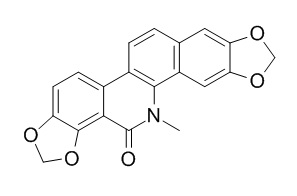Oxysanguinarine
Oxysanguinarine possesses antiplatelet aggregation activity, it has potential inhibitory properties against dengue virus.
Inquire / Order:
manager@chemfaces.com
Technical Inquiries:
service@chemfaces.com
Tel:
+86-27-84237783
Fax:
+86-27-84254680
Address:
1 Building, No. 83, CheCheng Rd., Wuhan Economic and Technological Development Zone, Wuhan, Hubei 430056, PRC
Providing storage is as stated on the product vial and the vial is kept tightly sealed, the product can be stored for up to
24 months(2-8C).
Wherever possible, you should prepare and use solutions on the same day. However, if you need to make up stock solutions in advance, we recommend that you store the solution as aliquots in tightly sealed vials at -20C. Generally, these will be useable for up to two weeks. Before use, and prior to opening the vial we recommend that you allow your product to equilibrate to room temperature for at least 1 hour.
Need more advice on solubility, usage and handling? Please email to: service@chemfaces.com
The packaging of the product may have turned upside down during transportation, resulting in the natural compounds adhering to the neck or cap of the vial. take the vial out of its packaging and gently shake to let the compounds fall to the bottom of the vial. for liquid products, centrifuge at 200-500 RPM to gather the liquid at the bottom of the vial. try to avoid loss or contamination during handling.
ACS Chem Biol.2019, 14(5):873-881
BMC Complement Altern Med.2016, 16:213
BMB Rep.2018, 51(5):249-254
Exp Biol Med (Maywood).2019, 244(16):1463-1474
Nutrients.2023, 15(6):1335.
Phytomedicine.2023, 116:154841.
Spectrochim Acta A2019, 210:372-380
J Med Food.2024, 27(8):728-739.
J Ethnopharmacol.2024, 320:117426.
BMC Plant Biol.2021, 21(1):60.
Related and Featured Products
J Vector Borne Dis. 2017 Jul-Sep;54(3):255-262.
Computer-aided analysis of phytochemicals as potential dengue virus inhibitors based on molecular docking, ADMET and DFT studies.[Pubmed:
29097641]
Dengue fever, caused by dengue virus (DENV), has become a serious threat to human lives. Phytochemicals are known to have great potential to eradicate viral, bacterial and fungal-borne diseases in human beings. This study was aimed at in silico drug development against nonstructural protein 4B (NS4B) of dengue virus 4 (DENV4).
METHODS AND RESULTS:
A total of 2750 phytochemicals from different medicinal plants were selected for this study. These plants grow naturally in the climate of Pakistan and India and have been used for the treatment of various pathologies in human for long-time. The ADMET studies, molecular docking and density functional theory (DFT) based analysis were carried out to determine the potential inhibitory properties of these phytochemicals. The ADMET analysis and docking results revealed nine phytochemicals, i.e. Silymarin, Flavobion, Derrisin, Isosilybin, Mundulinol, Silydianin, Isopomiferin, Narlumicine and Oxysanguinarine to have potential inhibitory properties against DENV and can be considered for additional in vitro and in vivo studies to assess their inhibitory effects against DENV replication. They exhibited binding affinity ≥ -8 kcal/mol against DENV4-NS4B. Furthermore, DFT based analysis revealed high reactivity for these nine phytochemicals in the binding pocket of DENV4-NS4B, based on ELUMO, EHOMO and band energy gap. INTERPRETATION &
CONCLUSIONS:
Five out of nine phytochemicals are reported for the first time as novel DENV inhibitors. These included three phytochemicals from Silybum marianum, i.e. Derrisin, Mundulinol, Isopomiferin, and two phytochemicals from Fumaria indica, i.e. Narlumicine and Oxysanguinarine. However, all the nine phytochemicals can be considered for in vitro and in vivo analysis for the development of potential DENV inhibitors.
Planta Med. 1999 Oct;65(7):643-7.
New tetrahydroprotoberberine N-oxide alkaloids and cytotoxic constituents of Corydalis tashiroi.[Pubmed:
17260290 ]
METHODS AND RESULTS:
Three new tetrahydroprotoberberine N-oxide alkaloids, (-)- cis-corydalmine N-oxide, (-)- trans-corydalmine N-oxide, and (-)- trans-isocorypalmine N-oxide, along with three known benzo[ C]phenanthridine alkaloids, norsanguinarine, dihydrosanguinarine, and Oxysanguinarine, six known berberine alkaloids, (-)-tetrahydropalmatine, (-)-corydalmine, (-)-scoulerine, (-)-corynoxidine, (-)-epicorynoxidine, palmatine, and protopine, have been isolated from the herb Corydalis tashiroi.
CONCLUSIONS:
The structures of these compounds were elucidated by spectroscopic analysis. Three of the isolated compounds show significant cytotoxic activities (ED (50) values < 4 microg/ml) against P-388, KB16, A549, and HT-29 cell lines.
Planta Med. 2001 Jul;67(5):423-7.
A new tetrahydroprotoberberine N-oxide alkaloid and anti-platelet aggregation constituents of Corydalis tashiroi.[Pubmed:
11488455]
METHODS AND RESULTS:
A new tetrahydroprotoberberine N-oxide alkaloid, (-)-cis-isocorypalmine N-oxide (1), together with two known compounds, 6-methoxydihydrosanguinarine (2) and norjuziphine (3), were isolated in continuing studies of the entire Formosan Corydalis tashiroi plant.
CONCLUSIONS:
The structures of these three compounds were determined through spectral analyses. In addition, compounds 1, 2, 3 and the seven alkaloids previously reported: (-)-cis-corydalmine N-oxide, (-)-trans-corydalmine N-oxide, (-)-trans-isocorypalmine N-oxide, scoulerine, protopine, Oxysanguinarine and corydalmine, were found to possess antiplatelet aggregation activity.



